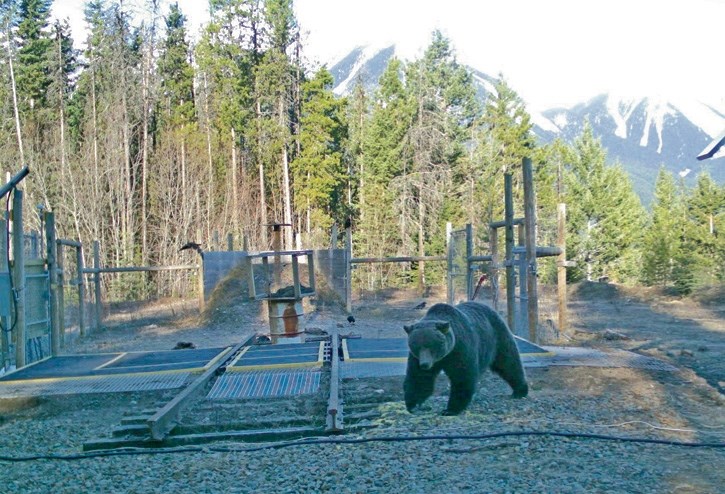Zapping grizzly bears with an electric shock shows promise as a way to keep grizzly bears off the deadly train tracks at mortality hotspots in Banff and Yoho national parks.
Parks Canada continues to investigate the use of hotwire fencing in combination with electrified mats to potentially deter bears from the railway in areas where several bears have died, including the “killing field” near Five Mile Bridge west of Banff.
Researchers say electrified mats are still experimental and further testing is needed to assess durability, and if they can be kept snow-free so bears still get an electric shock, and wildlife responses.
“We do feel they show promise, but there’s a few questions that remain and so they are still experimental,” said Anne Forshner, a wildlife ecologist in Lake Louise, Yoho and Kootenay. “There’s more work to be done.”
The research was started as part of the five-year, $1 million joint Canadian Pacific Railway-Parks Canada study to look at ways to reduce the number of bears dying on the train tracks.
There have been 17 known grizzly bear deaths on the railway in Banff and Yoho since 2000, but that number does not take into account bears that may have been struck and never found.
As part of the research, a mock section of railway, complete with an electric fence, was set up at two test sites located away from the railway. The mats deliver an electric shock to animals in the hope they won’t go on the tracks where fencing would end.
Beaver or elk carcasses were used to lure animals to the two test areas, while remote cameras recorded animal behaviour to give researchers information on the success or limitations of the technology.
Between 2013 and 2015, the mats, which deliver a low amperage current so as not to harm wildlife, deterred 85 per cent of all crossing attempts. That included eight species, including bears and wolves, and 34 individual attempts.
Wildlife crossed the electrified mats to get inside the test site eight times. Five of these occurred when the mat malfunctioned. One fox and two wolves crossed the mat when it was working.
“They are a promising technique to prevent wildlife from entering the railway line between fence ends,” Forshner said. “As soon as they got shocked, they would just take off for cover most of the time.”
Some animals tried to climb the fence instead of crossing the mat. Only one black bear was successful.
There were also eight times grizzly bears tried to dig under or get through the fence, and on two of those occasions, grizzly bears got in.
“We feel in an operational railway setting the additional motivation provided by the bait wouldn’t be there, so we don’t suspect they would be as inclined to break through the fence,” said Forshner.
The mats had a higher failure rate in winter, breaking down about once a month. In addition, animals were essentially insulated from getting an electric shock when the mats were covered in snow and ice.
“When the mats are working, they work, very, very well,” said Forshner.
Parks Canada later tested a non-electrified fence design in recognition that a hotwire fence over long distances and varied conditions would require intensive monitoring and maintenance, and could see occasional breaches and failures.
This non-electric fence was designed with an outward facing one-metre overhang at a 90-degree angle at the top of the fence.
Using motion-activated still and video cameras, researchers discovered one black bear and four known grizzly bears, particularly Banff’s most famous bears 122 and 148, tried to get into the baited fence site on 143 occasions.
There were only three times a bear got inside the fence – and that was bear 122, also known as the Boss. He pushed and pulled on the fence to manipulate weak points in the page wire to create a hole in the fence.
Other bears tried to dig under the fence, and even tried climbing, but none attempted to take a shot at actually getting over the one-metre overhang.
“The only successful method was that push-pull method. There was no successful climbing events, no successful digging events in which to access the bait,” said Dan Rafla, resource conservation officer with Banff National Park.
“Bear 122, the largest, strongest bear, was able to manipulate the fence. Bear 122 just leverages his body weight and strength against the fence and it was done over hours and hours and hours.”
A wolverine did get inside the fence 48 times, moving through the spacing of the page wire quite easily.
Rafla said the results provide evidence an overhanging fence modification could be used to deter bears from climbing fences along the railway or highway, and could be piloted on a trial basis in certain locations.
“The electrical hotwire is quite effective, but in a wilderness setting and over a long stretch of track there might be chances it would fail from time to time, potentially making the fence component of the mat design permeable to bears,” he said.
“Considering that, with the results we saw, any fencing in high-risk locations on a railway setting should not be an overhang in lieu of an electrified fence or electric wire, but a complement to each other.”
Bill Hunt, the head of resource conservation for Banff National Park, said a lot of time has been spent testing electromats and fences, noting the mats are now being piloted at access points onto the Trans-Canada Highway.
“Some of these are great in a research setting … getting those onto a railway is an entirely different problem for us, and for CP Rail,” he said.
“There’s still that second step of getting them into practical application in the field in a way that is sustainable.”




